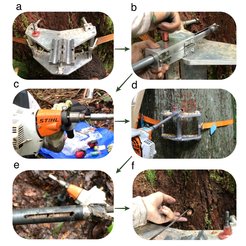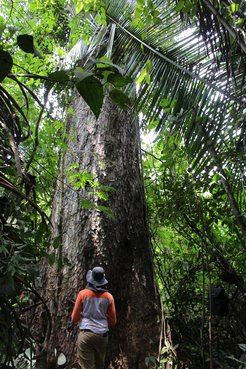Coring and Exploring the Amazon’s Giant Trees
New study presents a novel device for sampling giant trees in remote tropical forest regions.
In a new article published in Dendrochronologia, an international team of scientists report the development of a novel method for sampling large, high-density tropical trees in hard-to-access tropical regions. The study, led by scientists from the Max Planck Institute for the Science of Human History, alongside colleagues from the National Institute for Amazonian Research in Brazil, presents an updated coring system composed of a borer coupled to a hand-held drilling machine and a support attached to the tree. The system can collect cores of 1.5 mm in diameter and over 1.0 m in length.

Set up of the drilling device
The new methodology holds great promise for sampling large, old trees in the tropics which act as endangered ‘time capsules’ of information, storing records of past forest management by Indigenous populations, past climatic variations and extreme events. The novel device provides a core sample of an appropriate diameter and quantity for tree-ring analyses, stable isotope measurements and radiocarbon analyses on the same samples, broadening the possibilities of research within the now-blossoming sub-field of tropical dendrochronology.
What’s in a tree ring?
Dendrochronology studies the annual rings formed in some tree species to obtain information about their age and annual growth patterns. Detectable differences in the tree rings provide unique insights into past events, such as droughts or floods, and abrupt changes in tree growth associated with human management and disturbance.
In the current study, the researchers collected dozens of samples from Brazil-nut trees from five areas of the Amazon basin to test the new, non-destructive sampling method, in which small samples are removed from the bark to the center of the trees.

Sampling a Brazil nut tree at Tefe National Forest - Brazil
“Some of the trees we sampled are larger than 3 meters in diameter, which indicates that they were probably there before Europeans set foot in the Americas,” says Victor Caetano-Andrade, leading author of the article, from the Max Planck Institute for the Science of Human History, in Jena, Germany.
"The system is relatively simple to set up and the quality of the samples produced is very good, mainly due to the stability of the support. The added stability makes it possible to successfully collect samples of more than one meter inside the tree," continues Caetano-Andrade.
Tropical trees as witnesses of Indigenous and colonial forest management
The study of tree rings has, for many decades, been used in temperate environments to create a picture of how climate change and human activities have altered forests. However, this work has been limited in the tropics, due to the perception that the lack of seasonality limits the formation of growth rings.
“We now know, so far, of more than 200 species from tropical regions that form annual rings,” explains Caetano-Andrade.

Large Brazil nut tree at Tapirapé Aquiri National Forest, Brazil.
Tropical forests were long seen as barriers to human migration, agricultural experimentation and the formation of dense sedentary populations, even being considered 'Green Deserts' in the context of past human activities. However, over the last two decades, several studies from different areas have shown extensive evidence of the domestication of plants and animals, including forest management, landscape changes and deliberate translocation of wild species by ancient human societies.
“In the context of the burgeoning research area Tropical Archaeology, this new sampling approach opens up new possibilities for exploring past human influences on forest growth around the tropics – yielding new, long-term records that can be associated with human settlements located in the same forests in which these trees were growing” says Dr. Patrick Roberts of the Max Planck Institute.
Tree-ring counting can, together with radiocarbon dating, produce robust high-resolution chronologies or 'stratigraphies' of each tree's growth. In addition, these rings can be chemically analyzed to investigate how climatic conditions have changed over time and how these changes correlate with tree growth. By combining observations of tree growth with biochemical analyses and local historical and archaeological data, the scientists aim to shed light on the relationship between tree communities and past human societies and their economic practices.
“Understanding how forest management has changed following the arrival of European colonists and the rise of industrial powers over the course of the past five centuries has implications for the sustainable future and conservation of tropical forests, such as the Amazon,” continues Caetano-Andrade. “With these new records we have the possibility to interrogate the oldest biological witnesses of these forest changes,” he concludes.
Future interdisciplinary analysis of these trees, including the use of genetic analysis and isotopic studies, should enable more detailed investigations into how human forest management has changed in different parts of the tropics of the world, through pre-colonial, colonial, and industrial periods of human activity, with potential implications for conservation.


